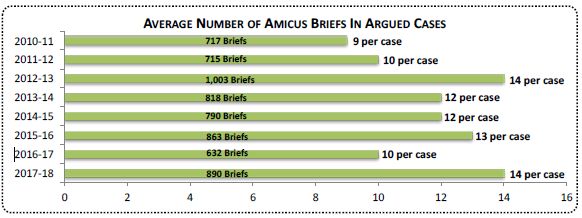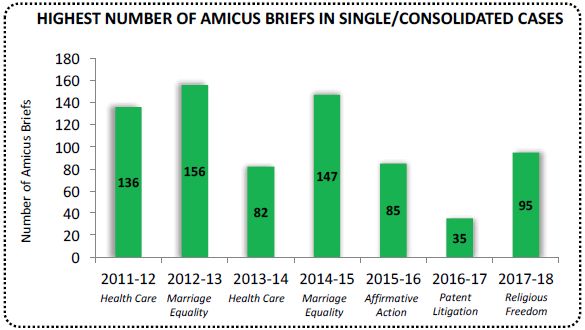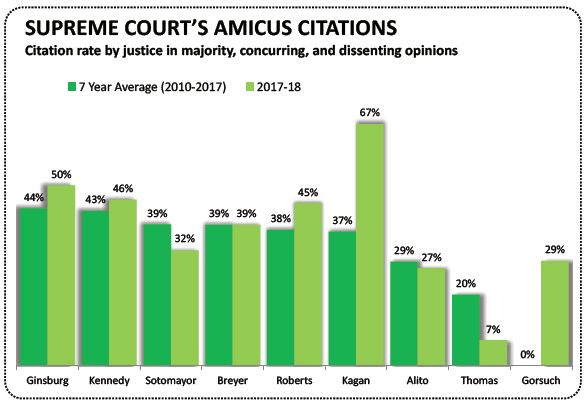Four things dominated the Supreme Court's 2017– 18 term: wedding cakes, immigration, unions—and amicus curiae. After a relatively quiet 2016–17 term, friends of the court roared back last term, with amici participating in every argued case and filing more briefs than ever.
In our eighth year analyzing the high court's amicus curiae docket for the National Law Journal, we found that amici—organizations and individuals spanning the ideological spectrum—continued to garner attention, with the justices regularly citing amicus briefs in their opinions and even jousting over them during oral argument.
A FRIEND FOR ALL SEASONS (AND CASES)
In 2017–18, amici filed briefs in every argued case, surpassing the past seven terms where participation rates ranged from 92 to 98 percent. Amici also filed more briefs. In the previous seven terms, amici filed on average between nine and 14 briefs per case, with the 2016–17 term marking a near seven-year low. In last year's assessment, we attributed the drop to the then eight-member Court hearing fewer cases on hot-button issues until a tie-breaking ninth member was confirmed. With the return of The Nine, the 2017–18 term saw a resurgence of marquee cases and a corresponding uptick in amicus submissions. Amici filed 890 briefs in 63 argued cases, averaging just over 14 briefs per case, a new record. These totals exclude an additional 98 amicus briefs filed in three merits cases that were fully briefed but dismissed before argument.

The return of mega cases also upped the number of amicus briefs filed in a single proceeding. "Cases with thirty or more amicus briefs are no longer particularly rare, and the highest-profile cases see amicus filings reaching the triple digits." Aaron- Andrew P. Bruhl & Adam Feldman, Separating the Amicus Wheat from Chaff, 106 Georgetown L. J. Online 135, 135 (2017). In 2016–17, with fewer blockbuster cases on the docket, the highpoint was 35 briefs in a single case, a seven-term low. But in 2017– 18, amici filed 95 briefs in Masterpiece Cakeshop, involving a baker's refusal to create a wedding cake for a samesex marriage. (One creative amicus brief included color photographs of elaborate wedding cakes to illustrate their artistry.) And amici filed 73 briefs in Trump v. Hawaii, involving the president's immigration travel ban.
While it is no surprise that today's "big" cases attract more briefs, it was not always so. Brown v. Board of Education had six amicus briefs, and Roe v. Wade generated only 23.
Last term, the justices occasionally noted the large number of amicus filings. In her dissenting opinion in Trump v. Hawaii, Justice Sotomayor highlighted the "scores of amici who have filed briefs" that described the "deleterious effects" of the travel ban. Justice Alito turned the tables in Janus v. State, County, and Municipal Employees, observing in his majority opinion that "neither respondents nor any of the 39 amicus briefs supporting them" provided an answer to an important issue regarding mandatory collection of public-employee union fees.
CITATION OF "GREEN" AND GOVERNMENT BRIEFS
One measure of whether an amicus brief makes a difference is if a justice cites it in an opinion. In the 2017–18 term, justices cited amicus briefs in 23 majority, 21 dissenting, and five concurring opinions. That is roughly the same number of majority opinions from the previous term, but more than double the citations to amici in dissents. The latter increase is attributable, in part, to the resurgence of 5-4 decisions, which made up a quarter of the cases in 2017–18 compared to 10 percent the year before when the Court had only eight members for most of the term.

Overall, the justices cited amicus briefs in 59 percent of the cases with signed majority opinions. That was up from 50 percent the previous term, and on the high end of the past seven terms where justices cited friend-of-the-court briefs in 46 to 63 percent of cases.
In 2017–18, the justices cited 11.9 percent (90/756) of the nongovernment briefs, called "green briefs" for the color of their covers. That is a high for the prior seven terms, where the justices cited between 5 and 11 percent of nongovernment briefs.

As for government amicus briefs, the justices cited 60 percent (12/20) of amicus briefs submitted by the Office of the Solicitor General in 2017–18, roughly in the middle of the 44 to 81 percent range over the prior seven terms.
THE BRIEFS THAT GOT NOTICED
Some scholars warn of "a growing threat of amicus overload, especially in the most salient cases, and the problem will only become more acute if current filing trends continue." Bruhl & Feldman, supra, at 135. So how do the justices and their clerks pluck the useful briefs from the massive pile? Some have proposed creative screening methods like "the use of plagiarism detection software as a tool to help identify the amicus briefs with the most useful and novel content." Id. at 136. Others have advocated for wholesale amicus reform, including a senator who questioned the propriety of modern amicus practice during a much-less-newsworthy portion of Justice Kavanaugh's confirmation hearings. Without any formal screening mechanisms, studies and common sense suggest that justices and their clerks often use proxies to identify helpful submissions. Two such proxies are subject matter and the identity of the filer.
On subject matter, in 2017–18 the justices continued to rely on briefs that provided "legislative facts"— "generalized facts about the world that are not limited to any specific case." Allison Orr Larsen, The Trouble With Amicus Facts, 100 Va. L. Rev. 1757, 1759 (2014). Last term, the justices cited amicus briefs for statistics, such as on how many people inform the Postal Service after they move, how many registered voters fail to vote (Husted v. A. Philip Randolph Institute), and how many people had Internet access in 1992 versus today (South Dakota v. Wayfair). As in prior terms, the justices also found useful briefs that provided surveys of laws, citing green briefs that compiled laws on statutes of limitations (Artis v. District of Columbia), "Indian-land bills" (Patchak v. Zinke), and tax laws relating to Internet sales (Wayfair).
The justices often turned to industry groups and companies for legislative facts. The justices' opinions included citations to briefs by the Institute of International Bankers on how a specific currency-exchange system works (Jesner v. Arab Bank), the American Gaming Association on the history of gaming and sports gambling (Murphy v. National Collegiate Athletic Ass'n), the Securities Industry and Financial Markets Association on the background of a particular securities law (China Agritech v. Resh), and cited briefs by companies like eBay and Etsy on the real-world complexities caused by inconsistent tax laws (Wayfair).
Studies also suggest that advocates and amici known for quality briefs get more attention. Allison Orr Larsen & Neal Devins, The Amicus Machine, 102 Va. L. Rev. 1901, 1922- 23 (2016); see also Adam Feldman, A Lot at Stake: Amicus Filers 2017/2018, Empirical SCOTUS, Jan. 16, 2018. During oral argument in the 2017– 18 term, Justice Breyer referred to a friend-of-the-court brief by the advocate's name, not the amicus curiae. See Tony Mauro, SCOTUS Gives Prized Nod to Arnold & Porter's Lisa Blatt at Travel Ban Argument, National L. J., Apr. 26, 2018. Justice Breyer later highlighted that brief in his dissenting opinion. Overall, about half of the green briefs cited by the justices were authored by firms that have established Supreme Court practices. And in 2017–18, the justices again turned to organizations known for quality submissions, citing briefs by the National Association of Criminal Defense Lawyers and the NAACP in multiple cases.
Briefs by academics also get "closer attention—at least initially." Kelly J. Lynch, Best Friends? Supreme Court Law Clerks on Effective Amicus Curiae Briefs, 20 J.L. & Pol. 33, 52 (2004). Despite some criticism of "scholar briefs," see Richard H. Fallon Jr., Scholars' Briefs and the Vocation of a Law Professor, 4 J. Legal Analysis 223 (2012), the justices in 2017– 18 continued to rely heavily on green briefs submitted by professors. During oral argument in Hughes v. U.S., four justices discussed UCLA Professor Richard Re's amicus brief that offered guidance on the proper interpretation of fragmented high court decisions. Tony Mauro & Marcia Coyle, Will Re's Amicus Brief Rule?, Supreme Court Brief, Mar. 28, 2018. Justice Kagan devoted 19 pages of her 25-page majority opinion in Ortiz v. U.S. to a jurisdictional question raised by UVA Professor Aditya Bamzai. Though rejecting Bamzai's position, Justice Kagan lauded the professor for provoking a serious argument "deserving of sustained consideration." Marcia Coyle, Kagan Gives UVA Prof Shoutout for Provoking 'Good and Hard Thinking,' Nat. L. J., June 22, 2018.
Finally, the justices repeatedly cited briefs by government entities. Given the Office of the Solicitor General's stellar reputation and institutional relationship with the Court, the justices frequently cited OSG briefs, even if only to express disagreement with the government's position (Digital Realty Trust v. Somers; Cyan v. Beaver County Employees Retirement Fund; Upper Skagit Indian Tribe v. Lundgren; WesternGeco LLC v. ION Geophysical Corp.). The 2017–18 term also found the justices citing to State amicus briefs for a range of topics, including State budgetary issues (Epic Systems Corp. v. Lewis; Janus), and how a decision would impact future legal proceedings or crime fighting (Currier v. Virginia; Carpenter v. U.S.).
THE JUSTICES' CITATION RATES
Over the prior seven terms, the justices varied substantially in how often they cited amicus briefs in their opinions. The 2017–18 term was no different, although some patterns are beginning to emerge.
Justice Ginsburg cited amicus briefs in half of her opinions in 2017–18, maintaining her status as a top amicus citer over the prior seven terms. Justice Thomas, with the lowest seven-term average, retained his position at the other end of the spectrum, citing amicus briefs in only 7 percent of his opinions in 2017–18. Justice Thomas's practice is also noteworthy because he cited only OSG amicus briefs, just as he did the term before. Justice Alito cited amicus briefs in only 27 percent of his opinions, in line with his seven-year average and among the lowest percentages of all the justices. In his first full term on the Court, Justice Gorsuch cited amicus brief in 29 percent of his opinions. With the retirement of Justice Kennedy, the Court lost one of its most prolific amicus citers.
Despite some criticisms and calls for reform, amicus practice at the Supreme Court continues its breakneck pace to file more briefs in more cases. And it appears that the justices continue to find amicus participation a benefit to the process, not a burden (though maybe their law clerks disagree). The current 2018–19 term—with a new justice and blockbuster cases in store— seems poised for another banner year for friends of the court.

Originally published by THE NATIONAL LAW JOURNAL
The content of this article is intended to provide a general guide to the subject matter. Specialist advice should be sought about your specific circumstances.

